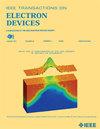Finding a Promising CMOS Inverter Architecture With Silicon Nanosheet for Future Technology Node
IF 2.9
2区 工程技术
Q2 ENGINEERING, ELECTRICAL & ELECTRONIC
引用次数: 0
Abstract
In this work, we systematically explore the static and dynamic performance of silicon nanosheet (NSH)-based complementary metal-oxide–semiconductor (CMOS) inverters, including complementary field-effect transistor (CFET), forksheet (FSH), and standard stacked NSH (s-NSH) configurations, for the 5 nm and beyond technology node. The performance analysis of CMOS inverters is conducted using 3-D process simulations in fully calibrated technology computer-aided design (TCAD) simulation, which is based on the self-consistent solution of the Boltzmann transport equation and Poisson’s equation with quantum and mobility correction terms. Our findings reveal that the CFET inverter achieves remarkable advancements by offering around a 3.7% boost in operating frequency and around −3.7% reduction in power dissipation while decreasing the area footprint by approximately −60.8% compared with the s-NSH inverter for the 1-nm technology node. Although the FSH inverter slightly lags behind CFET in performance metrics, it still outperforms the s-NSH inverter by delivering an around 3% increment in the frequency at an equivalent power level and an area reduction of around −6.9%. Furthermore, CFET demonstrates superior resilience to process parameter variations, including doping fluctuation, oxide thickness, interface trap charges, and channel thickness. This robustness, combined with their compact design and excellent gate electrostatic control, enables CFET inverters to consistently outperform both FSH and s-NSH inverters across all evaluated technology nodes and design parameters. These advantages firmly establish the CFET inverter as the preferred choice for future ultrascale technology nodes and low-power logic applications.求助全文
约1分钟内获得全文
求助全文
来源期刊

IEEE Transactions on Electron Devices
工程技术-工程:电子与电气
CiteScore
5.80
自引率
16.10%
发文量
937
审稿时长
3.8 months
期刊介绍:
IEEE Transactions on Electron Devices publishes original and significant contributions relating to the theory, modeling, design, performance and reliability of electron and ion integrated circuit devices and interconnects, involving insulators, metals, organic materials, micro-plasmas, semiconductors, quantum-effect structures, vacuum devices, and emerging materials with applications in bioelectronics, biomedical electronics, computation, communications, displays, microelectromechanics, imaging, micro-actuators, nanoelectronics, optoelectronics, photovoltaics, power ICs and micro-sensors. Tutorial and review papers on these subjects are also published and occasional special issues appear to present a collection of papers which treat particular areas in more depth and breadth.
 求助内容:
求助内容: 应助结果提醒方式:
应助结果提醒方式:


